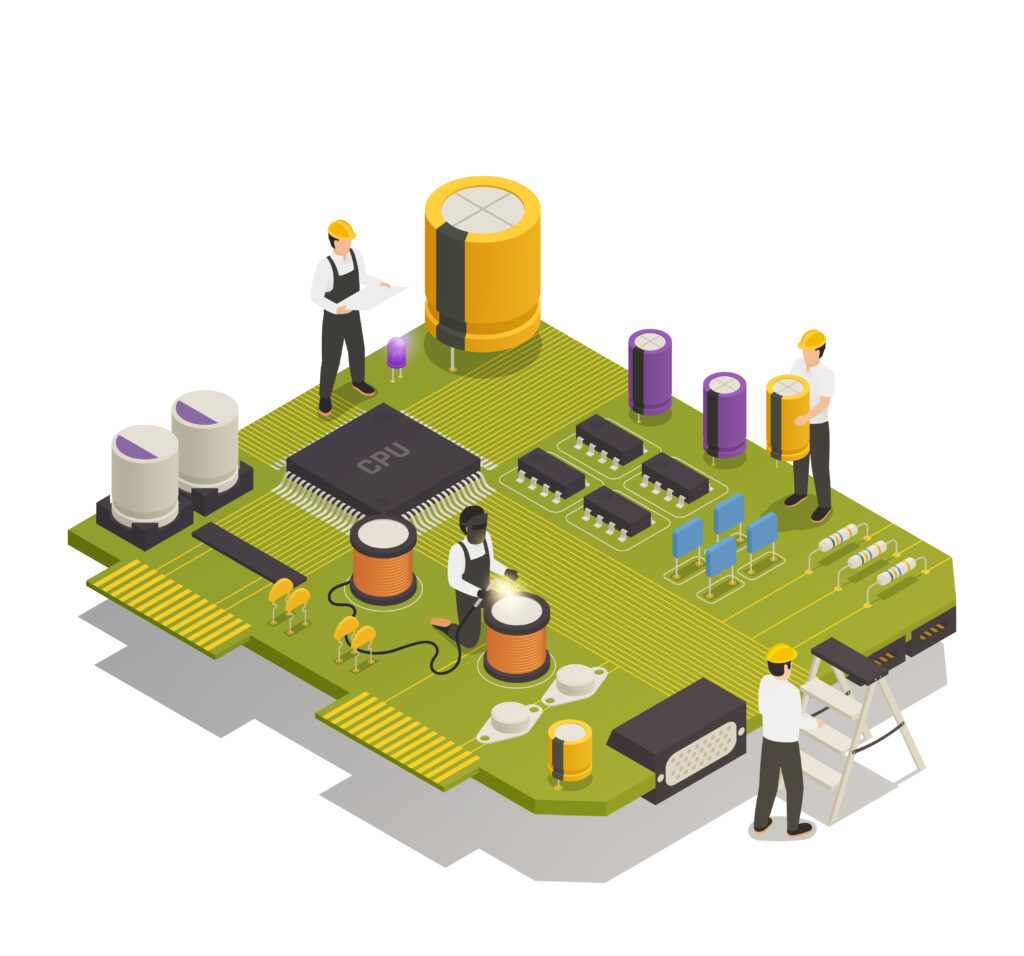The Internet of Things is making its presence felt in the industry by connecting millions of devices over the globe and creating a demand for efficient, flexible, and inexpensive fabric solutions. Among other technologies transforming this domain is Custom Application-Specific Integrated Circuits or ASICs. Custom ASICs are specially designed chips aimed at specific applications that provide better performance, energy efficiency, and integration capability relative to other solutions. This blog will tell you about the reasons custom ASICs are key components in IoT solutions and shaping innovation across industries.
- What Are Custom ASICs?
A Custom ASIC is a semiconductor chip which is specifically designed to carry out specific functions tailored for an application or device. They differ from general-purpose processors, such as CPUs and GPUs, because they are optimized to perform specific tasks, hence becoming more efficient and powerful. They are used where the application demands performance, size, and power consumption.
- Why IoT Needs Custom ASICs
IoT devices operate in various settings such as smart homes and wearable’s, industrial automation, and healthcare monitoring. Such applications have different requirements such as:
- Low power consumption: Many IoT devices work off batteries or energy harvesting; therefore, custom ASICs are designed to consume minimum power, thereby ensuring long lifetimes for devices.
- Compact form factor: Space considerations force the designs to be more compact, requiring single chip integration of multiple functionalities within one chip, reducing components needed.
- Reliability in Operations: Industrial and mission-critical IoT applications require strong hardware performance as reliability is the key requirement of them, including custom ASICs built around specific reliability standards
- Lower System Cost: When they are produced in large enough volume, custom ASICs achieve lower system costs compared with using multiple off-the-shelf components.
3. Key Benefits of Custom ASICs in IoT
- Power Efficiency: IoT devices must be energy-efficient, especially in remote or battery-powered applications. In the case of custom ASICs, engineers can optimize power use by incorporating only the necessary functions while also using power-saving design techniques, such as dynamic voltage scaling and power gating.
- Optimized Performance: Custom ASICs are designed to do very specific things at peak performance. For example, a security camera in a smart home could do real-time video streams with minimal power.
- Increased Security: IoT devices have increasingly come under cyber attack; the security aspect of things takes precedence. Custom ASICs will be able to put hardware level security features like secure boot, encryption engines, and tamper detection, which can do their job better than the pure software approach.
- Low Latency: Custom ASICs allow real-time data processing, which is an application in autonomous vehicles, industrial automation, and healthcare monitoring. Low-latency performance makes it possible to respond instantly, and therefore improves system reliability.
- Integration and Miniaturization: Custom ASICs reduce the need for external components because multiple functions are placed in a single chip, thus allowing for smaller and more compact devices. This is a necessity for wearable’s, medical implants, and other space-constrained IoT products.
To learn more about this and other breakthroughs and see what’s new in the industry, check out NanoGenius Technologies . Below, we explore the technologies that will shape tomorrow.
![]()
- Custom ASIC Use Cases in IoT
- Smart Homes and Consumer Electronics: Custom ASICs are used in smart home devices, such as thermostats, voice assistants, and security systems. These chips perform tasks such as real-time voice recognition, fast device control, and stable wireless connectivity. They are power-efficient, which means that devices run longer without frequent charging or high power demands.
- Enhancing Wearable Devices in medical area: Surely some devices which can be worn on the body have come in as game-changers. They use state-of-the-art sensors which allow patients to continuously monitor their vital signs like heart rates, blood pressures, glucose, and many others, thereby giving real-time feedback without the inconvenience of home kits or hospital visits. When paired with AI and ML, these devices will not only improve patient outcomes but also drive the medical field industry itself in the areas of clinical research and diagnostics. If anything, these devices, like cochlear implants and hearing aids, remote fertility monitors, and mobile cardiac telemetry have made possibilities boundless.
- Industrial Internet of Things (IIoT): Custom ASICs play critical roles in supporting tasks in industrial environments. They have applications in predictive maintenance, smart manufacturing, and automation control processes, ensuring accurate, real-time processing to prevent failure-related system downtime and thus enhance productivity.
- Automotive and Transportation: Custom ASICs are crucial to automotive applications such as ADAS, V2X communication, and self-driving technologies. These chips allow for processing data at high speeds for enhanced safety systems in vehicles, thereby greatly improving road safety and navigation accuracy.
- Agriculture and Environmental Monitoring: In agriculture, custom ASICs process sensor data related to soil moisture, temperature, and environmental conditions. The energy-efficient design supports long-term deployments in remote and challenging environments, making precision farming more accessible and sustainable.
- Design Challenges in Custom ASIC Development
Custom ASICs have many benefits; however, developing them is not an easy task. The following are some of the main difficulties involved in ASIC development:
- High Initial Development Costs: Custom ASIC development involves a large financial investment. The expenses occur in the design, fabrication, and testing phases. The use of special tools, experienced engineers, and fabrication facilities further increases the expenses and makes the process costly right from the beginning.
- Long Development Cycles: It takes so much time to develop a customized ASIC. Designing a prototype and manufacturing take several months or even years. Due to this long time line, careful project management and long term planning are necessary.
- Large Design Requirements: The design has to satisfy several fundamental critical design requirements at once. They must balance chip size (area), power, performance, and manufacturing cost. Not to forget that the semiconductor also has to be designed with sufficient reliability and scaling capabilities to meet future developments.
- Manufacturing Risk: Late in the design or production phase, mistakes can cause problems. Correcting design flaws after production has begun can be very expensive and may delay product launch. Thorough testing and verification are essential to minimize these risks.
Understanding these challenges helps in planning and managing custom ASIC development projects effectively.

Future Trends and Innovations in Custom ASICs for IoT
The future of custom ASICs in the Internet of Things is exciting, driven by emerging technologies and evolving market needs. Here are some key trends shaping the future of custom ASIC development:
- Artificial Intelligence at the Edge
Custom ASICs are now embedding AI accelerators to take intelligence directly to devices and make it possible to process real-time data without the requirement of cloud connectivity. In applications such as facial recognition, voice assistants, or predictive maintenance in industrial settings, this on-device AI functionality is useful.
- Ultra-Low-Power Designs
Power efficiency in IoT devices, especially when they are running on battery, is a critical aspect. Future advancements in semiconductor technology would enable ASICs that draw even less power, thus further extending the life of the device or reducing the frequency of charging or battery replacement.
- 5G and Beyond
With the deployment of 5G and the future wireless standards, ultra-reliable low-latency communication (URLLC) will employ custom ASICs in its support of mission-critical IoT applications like autonomous vehicles and remote health care systems to guarantee flawless connectivity.
- Advanced Security Features
Future custom ASICs, in the face of more complex cyber threats, will have built-in security. These will include advanced encryption techniques and even post-quantum cryptographic solutions to protect sensitive data against future computing threats, such as those from quantum computers.
All these innovations will usher in smarter, more efficient, and secure IoT devices and shape the future of connected technology.
Conclusion
Custom ASICs are changing the face of IoT by providing performance tailored for specific applications, better power efficiency, and greater integration capabilities. Although their development is difficult, the paybacks in the long term will be well worth the investments.
And as an industry scales its IoT technologies, the utility of custom ASICs will increasingly transition towards making smarter, more efficient, and secure connected devices. So, those industries that will spend on developing custom ASICs today will have a competitive advantage when the wave of the new innovation comes knocking at their doors in IoT.
Vendors, are you interested in learning more? Check out additional blogs and case studies on Nanogenius Technology’s website.

